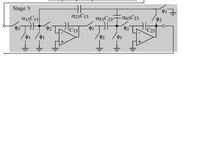jianjing526
Member level 2
hi all,
I'm designing a five-order chebyshev LPF. Three subckts cascaded to compose the filter, a one-order one and two biquads. There are five operational amplifiers. How to give out the specifications of these opamps? I'm confusing all these days!
I'm designing a five-order chebyshev LPF. Three subckts cascaded to compose the filter, a one-order one and two biquads. There are five operational amplifiers. How to give out the specifications of these opamps? I'm confusing all these days!
